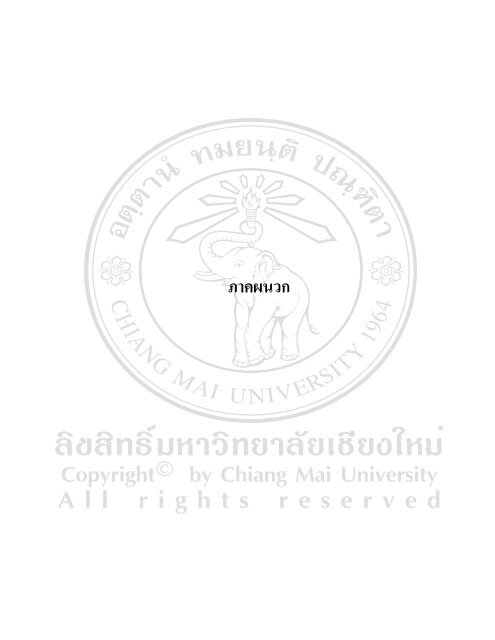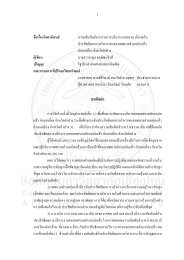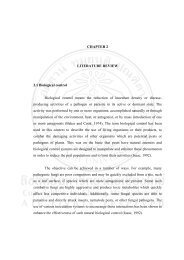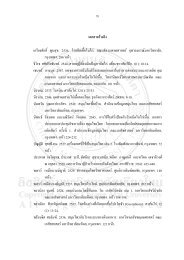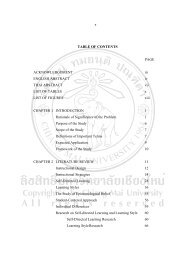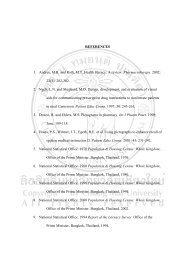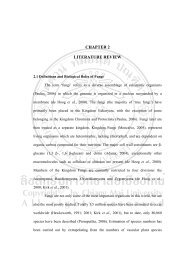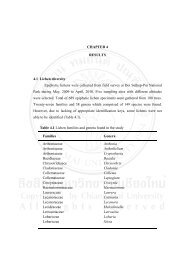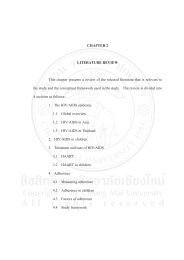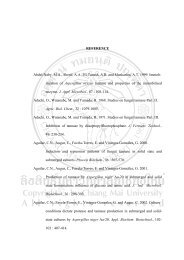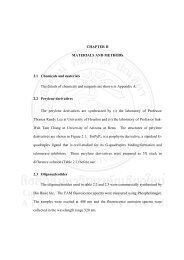ภาคผนวก
ภาคผนวก
ภาคผนวก
You also want an ePaper? Increase the reach of your titles
YUMPU automatically turns print PDFs into web optimized ePapers that Google loves.
<strong>ภาคผนวก</strong>
57<br />
<strong>ภาคผนวก</strong> ก<br />
รายนามผูเชี่ยวชาญ
58<br />
รายนามผูเชี่ยวชาญ<br />
1. ผูเชี่ยวชาญตรวจสอบแผนการสอนและแบบวัดทักษะการอานและการเขียนภาษาอังกฤษ<br />
อาจารยวิโรจน วันจันทร หมวดวิชาภาษาตางประเทศ<br />
โรงเรียนตลุกดูวิทยาคม<br />
จังหวัดอุทัยธานี<br />
2. ผูเชี่ยวชาญตรวจสอบเกณฑการใหคะแนน<br />
และใหคําปรึกษาการวิเคราะหขอมูล<br />
ดร. ดวงใจ สีเขียว หมวดวิชาคณิตศาสตร<br />
โรงเรียนบานจัน<br />
จังหวัดอุทัยธานี
59<br />
<strong>ภาคผนวก</strong> ข<br />
ตัวอยางแผนการสอนแบบ เค ดับเบิ้ลยู<br />
แอล พลัส
Subject : English<br />
Class : Beginner Students<br />
Topic : The Sun And the Moon<br />
Time : 100 minutes ( 2 period)<br />
Skills : Reading, Writing<br />
60<br />
LESSON PLAN 1<br />
Period 1-2<br />
Terminal Objective : Students can tell the differences between the sun and the<br />
moon.<br />
Enabling Objectives : Students should be able to<br />
1. answer questions from given passage.<br />
2. draw mind mapping from given passage.<br />
Procedures :<br />
Period 1<br />
Presentation<br />
Pre-Reading activities<br />
1. The teacher lets students brainstorm and discuss what they know<br />
about ‘The Sun And the Moon’.<br />
2. Teacher asks question while participating with students’<br />
discussion.<br />
- When does the sun shine?<br />
- Does the moon shine every night?<br />
- What does the sun look like?<br />
3. After students’ brainstorming and discussing, the teacher writes<br />
down what students know about ‘The Sun And the Moon’ in<br />
column K on the board. And then lets students note the sentence in<br />
their paper.<br />
4. The teacher explains the meaning of new words then students write<br />
down those meaning in their notebooks.<br />
5. The teacher asks students to generate questions regarding what<br />
they want to know more about ‘The Sun And the Moon’ in<br />
column W.
Practice<br />
Period 2<br />
Production<br />
61<br />
Reading activities<br />
6. Students read one paragraph of ‘The Sun And the Moon’ and<br />
check the answers of questions listed in column W. Then generate<br />
more questions before continuing reading.<br />
7. Students note answers and new information in column L about<br />
what they have learned.<br />
8. Students answer the questions from given passage in work sheet.<br />
Post-Reading activities<br />
9. Task : Students draw a mind mapping about ‘The Sun And the<br />
Moon’.<br />
Materials : picture, reading passage, mind mapping<br />
Evaluation : The students will be able evaluated in the following ways :<br />
1. from their participation with activities<br />
2. from their reading comprehension exercises<br />
3. from their mind mappings
62<br />
The Sun and the Moon<br />
The sun shines during the day. The moon and stars shine at night.<br />
During the day it is light, but at night it’s dark.<br />
The moon does not shine every night. Sometimes we do not see the<br />
moon because there are clouds in the sky. Sometimes we do not see the<br />
moon even when the sky is clear because the moon always changes.<br />
The moon has no light of its own. It gets light from the sun. If we<br />
look at our earth from the moon, we will see our earth as a big “moon”.<br />
Our earth is bigger than the moon. But the sun is very much bigger<br />
than the earth. The sun is very far away. It is a big ball of fire.<br />
Stars are balls of fire, too. They look small because they are very,<br />
very far way from us. Many stars are much bigger than our sun. Our sun<br />
is star. It is the star nearest to our earth.<br />
Vocabularies<br />
shine = สองแสง during = ระหวาง light = แสง<br />
clear = แจมใส change = เปลี่ยนแปลง<br />
fire = ไฟ
63<br />
Worksheet<br />
The Sun And the Moon<br />
Part A : Fill in the blank to complete sentences.<br />
1. The sun ……………. during the day.<br />
2. At night it is ………….. .<br />
3. The moon has no ……………… of its own.<br />
4. The earth …………….. than the moon.<br />
5. The sun is very ……………. from the earth.<br />
6. Our sun is a ……………..<br />
7. …………………… we do not see the moon.<br />
8. The moon get its …………….. from the sun.<br />
9. There are ……………………… in the sky.<br />
10. The sun is a ……………. on fire.<br />
Part B : Choose the best answer for the following question.<br />
1. When does the moon shine?<br />
a. During the day b. At night<br />
2. The moon does not always shine because ………………<br />
a. the moon changes b. there are clouds<br />
3. Does the moon have its own light?<br />
a. Yes, it does. b. No, it doesn’t<br />
4. We can see the moon if ……………..<br />
a. the stars shine b. the sky is clear<br />
5. Which is bigger?<br />
a. Our earth b. The sun<br />
6. Where does the moon get its light?<br />
a. From the sun b. From the earth<br />
7. What does the sun look like?<br />
a. big moon. b. A big ball.<br />
8. Why do the star look very small?<br />
a. Because they are very far away. b. Because they are smaller than the sun.<br />
9. Which is the nearest star to our earth?<br />
a. The sun b. The moon.<br />
10. does the moon shine every night?<br />
a. Yes, it does. b. No, it does not.
K<br />
64<br />
W<br />
L
65<br />
MIND MAPPING<br />
STORY : ……………………………………………….<br />
NAME…………………………………………………….CLASS…………………..
Subject : English<br />
Class : Beginner Students<br />
Topic : Nai Porn’s House<br />
Time : 100 minutes ( 2 period)<br />
Skills : Reading, Writing<br />
66<br />
LESSON PLAN 3<br />
Period 5-6<br />
Terminal Objective : Students can describe about Nai Porn’s house and his animals.<br />
Enabling Objectives : Students should be able to<br />
1. answer questions from given passage.<br />
2. draw mind mapping from given passage.<br />
Procedures :<br />
Period 1<br />
Presentation<br />
Pre-Reading activities<br />
1. The teacher lets students brainstorm and discuss what they know<br />
about ‘Nai Porn’s House’.<br />
2. Teacher asks question while participating with students’ discussion.<br />
- What is Nai Porn?<br />
- Which kind of animal does Nai Porn have?<br />
- Where does he keep his buffaloes?<br />
3. After students’ brainstorming and discussing, the teacher writes<br />
down what students know about ‘Nai Porn’s house.’ in column K on<br />
the board. And then lets students note the sentence in their paper.<br />
4. The teacher explains the meaning of new words then students write<br />
down those meaning in their notebooks.<br />
5. The teacher asks students to generate questions regarding what they<br />
want to know more about ‘Nai Porn’s House’ in column W.
Practice<br />
Period 2<br />
Production<br />
Reading activities<br />
67<br />
6. Students read one paragraph of ‘Nai Porn’s house.’ and check the<br />
answers of questions listed in column W. Then generate more<br />
questions before continuing reading<br />
7. Students note answers and new information in column L about what<br />
they have learned.<br />
8. Students answer the questions from given passage in work sheet.<br />
Post-Reading activities<br />
9. Task : Students draw a mind mapping about ‘Nai Porn’s House’.<br />
Materials : picture, reading passage, mind mapping<br />
Evaluation : The students will be able evaluated in the following ways :<br />
1. from their participation with activities<br />
2. from their reading comprehension exercises<br />
3. from their mind mappings
68<br />
Nai Porn’s House<br />
This is a farmer’s house. It is a small house made of wood. Nai Porn and his wife live in<br />
this house. They keep their buffaloes near their house. These buffaloes are useful to them. They<br />
use the buffaloes to plow the field before they grow rice.<br />
There is a pond in front of their house. The water in this pond is not very clean. They<br />
always boil water before they drink it.<br />
Buffaloes like water. There are many ponds for the buffaloes in the field. Buffaloes like<br />
to rest in water and mud. When the mud is dry, it keeps them from mosquitoes.<br />
Today is wan-pra day. Nai Porn does not go to work in the field. He stays home. He is<br />
going to go to the temple. He is reading a newspaper. He has a cup of coffee in his hand.<br />
A man is driving a cart near the house. The man is standing on the cart. Two buffaloes<br />
are pulling the cart along. He is a friend of Nai Porn. He is going to town. He buys things in town<br />
and brings them back in his cart.<br />
Vocabularies<br />
<br />
made of = ทําดวย useful = มีประโยชน plow = ไถนา field = ทุงนา<br />
grow = ปลูก pond = บอน้ํา<br />
boil = ตม rest = พักผอน<br />
mud = โคลน dry = แหง keep = ปองกัน mosquitoe = ยุง<br />
stay = อยู<br />
drive = ขับ cart = เกวียน<br />
pull along = ลากจูง town = เมือง bring back = นํากลับมา
WORKSHEET<br />
NAI PORN’S HOUSE<br />
PART A : Write TRUE or FALSE in front of the sentences.<br />
1. ……………Nai Porn is a farmer.<br />
2. ……………There is a buffalo in front of their house.<br />
3. ……………They grow rice before they plow the field.<br />
4. ……………The water in the pond is very clean.<br />
5. ……………There are many ponds for the buffaloes.<br />
6. ……………Dry mud keeps the buffaloes from mosquitoes.<br />
7. ……………Nai Porn goes to work on Wan-Pra.<br />
8. ……………A man with a cart is going to the temple.<br />
9. ……………Nai Porn is reading a newspaper.<br />
10. …………..Nai Porn’s friend is going to buy things in town.<br />
PART B : Write short answer about Nai Porn’s House.<br />
1. Who lives in the house?<br />
……………………………………………………………………………………..<br />
2. Why are those buffaloes useful?<br />
……………………………………………………………………………………...<br />
3. What is in front of Nai Porn’s house?<br />
………………………………………………………………………………………<br />
4. What do buffaloes like?<br />
………………………………………………………………………………………<br />
5. Why is dry mud useful to buffaloes?<br />
………………………………………………………………………………………<br />
6. Where do buffaloes like to rest?<br />
………………………………………………………………………………………<br />
7. What does Nai Porn do on Wan-Pra?<br />
………………………………………………………………………………………<br />
8. What is Nai Porn’s friend doing?<br />
………………………………………………………………………………………<br />
69
K<br />
70<br />
W<br />
L
71<br />
MIND MAPPING<br />
STORY : ……………………………………………….<br />
NAME…………………………………………………….CLASS…………………..
Subject : English<br />
Class : Beginner Students<br />
Topic : Food can be kept clean.<br />
Time : 100 minutes ( 2 period)<br />
Skills : Reading, Writing<br />
72<br />
LESSON PLAN 6<br />
Period 11-12<br />
Terminal Objective : Students can tell about useful of food.<br />
Enabling Objectives : Students should be able to<br />
1. match pictures of food with their useful<br />
2. draw mind mapping from given passage.<br />
Procedures :<br />
Period 1<br />
Presentation<br />
Pre-Reading activities<br />
1. The teacher lets students brainstorm and discuss what they know<br />
about useful of food.<br />
2. Teacher asks question while participating with students’ discussion.<br />
- Which is the most useful food?<br />
- Where can you get vitamins?<br />
- What will you do to keep food?<br />
3. After students’ brainstorming and discussing, the teacher writes<br />
down what students know about ‘Food can be kept clean.’ in<br />
column K on the board. And then lets students note the sentence in<br />
their paper.<br />
4. The teacher explains the meaning of new words then students write<br />
down those meaning in their notebooks.<br />
5. The teacher asks students to generate questions regarding what they<br />
want to know more about ‘Food can be kept clean.’ in column W.
Practice<br />
Period 2<br />
Production<br />
73<br />
Reading activities<br />
6. Students read one paragraph of ‘Food can be kept clean.’ and check<br />
the answers of questions listed in column W. Then generate more<br />
questions before continuing reading.<br />
7. Students note answers and new information in column L about what<br />
they have learned.<br />
8. Students match the pictures of food with their useful. And fill in the<br />
blanks about the passage.<br />
Post-Reading activities<br />
9. Task : Students draw a mind mapping about ‘Food can be kept<br />
clean’.<br />
Materials : picture, reading passage, mind mapping<br />
Evaluation : The students will be able evaluated in the following ways :<br />
1. from their participation with activities<br />
2. from their reading comprehension exercises<br />
3. from their mind mappings
74<br />
Food Can Be Kept Clean<br />
Milk is good for everybody. It is good for babies and older people too. Milk usually<br />
comes in the bottles. But sometimes it is put into cans. It is canned by milk factories.<br />
Today most food can be bought in cans. Food is canned to keep it from the air. Food is<br />
usually kept cold in our refrigerator.<br />
Food is transported into cities day and night – in ships, trains or trucks. It is kept cold<br />
and clean all the way. Today food is transported by air too.<br />
We get milk from cows. Some city-born children have never seen a cow. School teachers<br />
teach them. These children are taught where milk comes from.<br />
In milk there is fat and vitamins. Fat gives energy to our bodies. Vitamins keep us<br />
healthy. A hundred years ago no one knew anything about vitamins.<br />
The vitamins are named by letters of the alphabet – Vitamins A, B, C,…. Vitamin A is<br />
needed by the eyes. There is Vitamin A in milk, butter and green vegetables. It can be stored by<br />
our bodies. But Vitamin B cannot be stored. It must be supplied all the time by some of food we<br />
eat.The skins of grains of rice and corns have Vitamin B in them.
75<br />
WORK SHEET<br />
FOOD CAN BE KEPT CLEAN<br />
PART A : Match the following pictures of food with their useful correctly.<br />
1. Good for babies.<br />
2. Gives energy to our bodies.<br />
3. Good for eyes.<br />
4. Good for out teeth.<br />
5. Good for our skin.<br />
PART B : Fill in the blanks.<br />
1. Milk is ……………………..for babies, children and other people.<br />
2. We get milk from ………………………..<br />
3. Sometimes milk is ………………………. into cans.<br />
4. Today most food can be ………………………. in cans.<br />
5. Food is ……………………….. into cities day and night.<br />
6. Food is ……………………….. cold and clean all the way.<br />
7. Some city-born children are ……………………….. where milk comes from.<br />
8. Vitamins are …………………………. by the letters of the alphabet-A, B, C, ….
76<br />
9. Vitamin A is ………………………..by the eyes.<br />
10.Vitamin A can be ………………………in our bodies.
77<br />
MIND MAPPING<br />
STORY : ……………………………………………….<br />
NAME…………………………………………………….CLASS…………………..
78<br />
<strong>ภาคผนวก</strong> ค<br />
แบบทดสอบวัดทักษะการอานภาษาอังกฤษ
79<br />
ENGLISH TEST FOR KWL APPROACH<br />
Read the following story and choose the best answer.<br />
“Maria Carra”<br />
Maria Carra is Jessica’s friend. She is nineteen years old and she<br />
comes from a town called Trento in Italy. She is a student and she lives<br />
at home with her parents. Her father is a policeman and her mother is a<br />
journalist. She has also got a brother-Giovanni. He is twenty-four and he<br />
is married, but he hasn’t got any children. 5<br />
At the moment she is in England. She is staying in a town called<br />
Hasting with a very nice English family the Simpsons. They’ve got a big<br />
house near the station in Castle Road. 8<br />
She has come here to learn English and she goes to the Regency<br />
School of English every morning from 9.30 to 12.30. She like learning<br />
English and she also interested in dancing, tennis and swimming. 11<br />
1. What nationality is Maria Carra?<br />
a. English. b. Italian.<br />
c. American. d. Spanish.
2. How many people altogether are there in Maria’s family?<br />
a. 5 b. 4 c. 3 d. 2<br />
3. Where is Maria living now?<br />
80<br />
a. Trento b. Italy c. Hastings d. England<br />
4. Whom did Maria use to live with?<br />
a. her friend b. her sisiter<br />
c. her brother d. her parents<br />
5. Who is Giovanni?<br />
a. Maria’s father. b. Maria’s friend.<br />
c. Maria’s brother. d. Maria’s neighbour.<br />
6. How many children does Maria’s brother have?<br />
a. one child b. two children c. three children d. none<br />
7. Who are “the Simpsons”?<br />
a. an Italian family b. an Spanish family<br />
c. an English family d. an American family<br />
8. (line7)They’ve got a big house near the station.What does “they” refer<br />
to?<br />
a. Hastings. b. the Simpsons.<br />
c. Giovanni and his wife. d. Mr. and Mrs. Carra.
81<br />
9. (line9) She has come here to learn English. What does “here” refer to?<br />
a. Italy<br />
b. Spain<br />
c. England.<br />
d. America<br />
10. What does Maria do on her free time?<br />
a. dancing,reading,swimming b. dancing,tennis,reading<br />
c. dancing,tennis,swimming d. dancing,tennis,skiing<br />
Animals in the North Pole<br />
It is cold in the North Pole. It is called the land of ice because<br />
there is ice and snow everywhere. In this land there are animals. Many<br />
kinds of animals can live in the cold North. They can live because they<br />
keep themselves warm.<br />
4
82<br />
When it is cold, you wear thick clothes to keep you warm. Animals have<br />
very thick fur to keep them warm. The cold wind cannot blow through it.<br />
The warm fur covers an animal from head to toe. A polar bear has fur<br />
even under his feet dry and warm. 8<br />
The polar bear’s fur is white. The color of his fur is the same as<br />
snow. Eskimos hunt the polar bear. They like to eat bear meat. The bear’s<br />
fur makes warm clothes. It is hard for a hunter to see a polar bear,<br />
because his fur is almost the same color as the snow. 12<br />
The polar bear’s white fur also helps him when he goes hunting. He<br />
sees the seal but the seal cannot see him. The polar bear catches the<br />
seal for his food. 15<br />
Polar bears are white all the year round. Other animals change<br />
colors. The fox in the North Pole is also white. But he is white only as<br />
long as there is snow on the ground. When there is no snow, his white hair<br />
goes off. He grows gray hair. It is hard to see him when the ground is<br />
dark. 19<br />
11. This story is about ……………………………… .<br />
a. the polar bear and Eskimos<br />
b. the hunters in the North Pole<br />
c. the animals in the North Pole<br />
d. the colors changing of animals in the North Pole<br />
12. Some animals can live in the North Pole because………………….<br />
a. They have thick fur.<br />
b. They can sleep for a long time.<br />
c. They have enough food for eat.<br />
d. They keep their food in the ground.
83<br />
13. Which animal has the same color as snow?<br />
a. a fox. b. a hare.<br />
c. a seal. d. a Polar bear.<br />
14. What does ‘he’ in line 13 refer to?<br />
a. hare b. polar bear.<br />
c. seal d. fox.<br />
15. Having white fur, the polar bear can …………………………..<br />
a. catch the fox easily<br />
b. get away from the hunter<br />
c. move around the North Pole<br />
d. find enough food for eat along winter<br />
16. According to the story, polar bear food are ………………………..<br />
a. foxes b. hares<br />
c. seals d. fish<br />
17. Why do Eskimos hunt polar bear?<br />
a. Because polar bear hunts their babies.<br />
b. Because they want polar bear’s meat and fur.<br />
c. Because hunting polar bear is an Eskimos’ game.<br />
d. Because polar bear always breaks their houses.
18. What is the real color of the fox?<br />
a. White. b. Grey.<br />
c. Black. d. As snow<br />
19. What is a difference between polar bear and fox?<br />
a. A fox has white fur.<br />
b. A polar bear has white fur.<br />
c. A fox hunts a seal for his food.<br />
84<br />
d. A polar bear hunts a fox for his food.<br />
20. (line 19) “It is hard to see him when the ground is dark.”, the underlined<br />
word refer to…………..<br />
a. polar bear b. fox c. seal d. hare<br />
All Living Things Must Have Food<br />
All living things must have food. We buy food from the market. Animals have<br />
to find their own food. Some animals eat grass. Some animals eat other<br />
animals. Trees and grass are living things, too. They must have food. They<br />
take their food from the ground. They eat food through their roots. 4
We must have money to buy food. We must work hard to get enough money.<br />
Animals must work hard to find food. In some places it is very hard to find<br />
enough food. In the North Pole there is snow everywhere in winter. And it is<br />
winter for six months. Animals must try hard to find the plants. The hare is<br />
very good at digging. They dig tunnels in the snow. The tunnels go down to<br />
the ground. On the ground there are plants. Inside tunnels, the little animals<br />
can eat without being seen. 11<br />
Wolves and foxes eat other animals like hares. Small fish eat plants in the<br />
sea. Big fish like whales eat small fish. Seals also like to eat fish. And the<br />
polar bears eat them. 14<br />
It is easier to find food in the Tropics for the animals that eat grass and<br />
plants. Plants are everywhere in the Tropics. But animals have more enemies<br />
here. There are many more kinds of animals that eat other animals. Tigers<br />
and lions are animals that eat other animals in the Tropics. Animals in the<br />
Tropics must try hard to live. They have too many enemies to escape. 19<br />
21. What is this story about?<br />
a. Weather in the North Pole and Tropics.<br />
b. All of living things in this world need food.<br />
c. Animals must try hard to find food in the ground.<br />
d. Human and animals must find food from the plant.<br />
85
22. According to the story, how does human get food?<br />
a. They get food by using money.<br />
b. They get food by cutting plants.<br />
c. They get food by hunting animals.<br />
d. They get food by digging into the ground.<br />
23. Where do trees and grass get food?<br />
a. from the animals b. from their roots<br />
c. from their leaves d. from hunting other plants<br />
24. What do wolves eat?<br />
a. little animals. b. human. c. plants. d. other wolves.<br />
25. Why do hares dig the tunnels?<br />
a. To keep their food inside. b. To hide from big animals.<br />
c. To sleep through the winter. d. To find food in the ground.<br />
26. What do ‘the little animals’ in line 10 refer to?<br />
a. hares b. seals c. foxes d. tigers<br />
86<br />
27. Which animal eat plants?<br />
a. wolf b. hare c. seal d. lion<br />
28. What does “them” in line 14 refer to?<br />
a. polar bears b. seals<br />
c. whales d. fish<br />
29. What is the difference between living in the North Pole and in the<br />
Tropics?<br />
a. It’s hard to find food in the Tropics.<br />
b. It’s easier for animals to find food in the Tropics.<br />
c. It’s hard to live with other animals in the North Pole.<br />
d. It’s easier for animals to find food in the North Pole.
30. It is difficult for the animals to live in the Tropics because…………………….<br />
a. there is snow everywhere<br />
b. there is not enough food<br />
c. there are a lot of enemies<br />
d. there are not enough plants<br />
87<br />
@@@@@@@@@@@@@@@@@@@@@@
88<br />
<strong>ภาคผนวก</strong> ง<br />
แบบวัดทักษะการเขียนภาษาอังกฤษ
89<br />
MIND MAPPING<br />
STORY : ……………………………………………….<br />
NAME…………………………………………………….CLASS…………………..
90<br />
<strong>ภาคผนวก</strong> จ<br />
รายละเอียดการคํานวณ
ตาราง 5 ผลการวิเคราะหคาความยากงาย (p) และคาอํานาจจําแนก ® เปนรายขอของแบบทดสอบ<br />
วัดทักษะการอานภาษาอังกฤษ<br />
่ ่ ขอที คาความยาก คาอํานาจจําแนก ขอที คาความยาก คาอํานาจจําแนก<br />
1 0.56 0.63 16 0.44 0.64<br />
2 0.42 0.42 17 0.39 0.46<br />
3 0.28* 0.40 18 0.69 0.63<br />
4 0.40 0.56 19 0.62 0.45<br />
5 0.46 0.64 20 0.58 0.62<br />
6 0.63 0.43 21 0.27* 0.49<br />
7 0.54 0.52 22 0.70 0.54<br />
8 0.62 0.62 23 0.43 0.68<br />
9 0.66 0.54 24 0.38 0.46<br />
10 0.44 0.56 25 0.67 0.49<br />
11 0.39 0.45 26 0.56 0.58<br />
12 0.46 0.57 27 0.57 0.64<br />
13 0.45 0.68 28 0.37 0.47<br />
14 0.57 0.69 29 0.44 0.45<br />
15 0.63 0.53 30 0.63 0.66<br />
หมายเหตุ * คือขอที่ปรับปรุงกอนนําไปใช<br />
91
่<br />
ตาราง 6 คะแนนความสามารถในการอานภาษาอังกฤษ กอนและหลังการสอนแบบ เค ดับเบิ้ลยู<br />
แอล พลัส จํานวน 46 คน<br />
เลขที คะแนนกอนเรียน ระดับความสามารถ คะแนนหลังเรียน ระดับความสามารถ<br />
1 12 พอใช 18 ปานกลาง<br />
2 17 ปานกลาง 21 ดี<br />
3 14 พอใช 20 ดี<br />
4 15 ปานกลาง 22 ดี<br />
5 18 ปานกลาง 25 ดีมาก<br />
6 13 พอใช 19 ปานกลาง<br />
7 16 ปานกลาง 19 ปานกลาง<br />
8 11 พอใช 16 ปานกลาง<br />
9 14 พอใช 20 ดี<br />
10 13 พอใช 20 ดี<br />
11 15 ปานกลาง 21 ดี<br />
12 11 พอใช 20 ดี<br />
13 16 ปานกลาง 20 ดี<br />
14 14 พอใช 18 ปานกลาง<br />
15 12 พอใช 17 ปานกลาง<br />
16 12 พอใช 16 ปานกลาง<br />
17 13 พอใช 19 ปานกลาง<br />
18 11 พอใช 19 ปานกลาง<br />
19 12 พอใช 18 ปานกลาง<br />
20 14 พอใช 21 ดี<br />
21 13 พอใช 22 ดี<br />
22 12 พอใช 17 ปานกลาง<br />
23 8 ตองปรับปรุง 13 พอใช<br />
24 9 ตองปรับปรุง 15 ปานกลาง<br />
25 12 พอใช 18 ปานกลาง<br />
92
ตาราง 6 คะแนนความสามารถในการอานภาษาอังกฤษ กอนและหลังการสอนแบบ เค ดับเบิ้ลยู<br />
แอล<br />
พลัส จํานวน 46 คน (ตอ)<br />
เลขที<br />
่ คะแนนกอนเรียน ระดับความสามารถ คะแนนหลังเรียน ระดับความสามารถ<br />
26 12 พอใช 19 ปานกลาง<br />
27 13 พอใช 20 ดี<br />
28 10 พอใช 15 ปานกลาง<br />
29 14 พอใช 21 ดี<br />
30 11 พอใช 14 พอใช<br />
31 12 พอใช 16 ปานกลาง<br />
32 15 ปานกลาง 18 ปานกลาง<br />
33 15 ปานกลาง 21 ดี<br />
34 16 ปานกลาง 23 ดี<br />
35 15 ปานกลาง 22 ดี<br />
36 6 ตองปรับปรุง 15 ปานกลาง<br />
37 13 พอใช 22 ดี<br />
38 14 พอใช 20 ดี<br />
39 14 พอใช 17 ปานกลาง<br />
40 12 พอใช 18 ปานกลาง<br />
41 20 ดี 25 ดีมาก<br />
42 15 ปานกลาง 21 ดี<br />
43 15 ปานกลาง 22 ดี<br />
44 16 ปานกลาง 24 ดี<br />
45 15 ปานกลาง 20 ดี<br />
46 12 พอใช 18 ปานกลาง<br />
93
่<br />
ตาราง 7 คะแนนความสามารถในการเขียนภาษาอังกฤษ กอนและหลังการสอนแบบ เค ดับเบิ้ลยู<br />
แอล พลัส จํานวน 46 คน<br />
เลขที คะแนนกอนเรียน ระดับความสามารถ คะแนนหลังเรียน ระดับความสามารถ<br />
1 8 พอใช 13 ดีมาก<br />
2 6 พอใช 12 ดี<br />
3 6 พอใช 12 ดี<br />
4 8 พอใช 10 ดี<br />
5 6 พอใช 10 ดี<br />
6 8 พอใช 13 ดีมาก<br />
7 4 ตองปรับปรุง 13 ดีมาก<br />
8 4 ตองปรับปรุง 10 ดี<br />
9 10 ดี 14 ดีมาก<br />
10 10 ดี 13 ดีมาก<br />
11 10 ดี 14 ดีมาก<br />
12 4 ตองปรับปรุง 12 ดี<br />
13 4 ตองปรับปรุง 10 ดี<br />
14 5 ตองปรับปรุง 13 ดีมาก<br />
15 6 พอใช 12 ดี<br />
16 8 พอใช 12 ดี<br />
17 12 ดี 14 ดีมาก<br />
18 6 พอใช 12 ดี<br />
19 8 พอใช 12 ดี<br />
20 10 ดี 13 ดีมาก<br />
21 10 ดี 14 ดีมาก<br />
22 10 ดี 12 ดี<br />
23 8 พอใช 12 ดี<br />
24 6 พอใช 13 ดีมาก<br />
25 6 พอใช 12 ดี<br />
94
ตาราง 7 คะแนนความสามารถในการเขียนภาษาอังกฤษ กอนและหลังการสอนแบบ เค ดับเบิ้ลยู<br />
แอล พลัส จํานวน 46 คน (ตอ)<br />
เลขที<br />
่ คะแนนกอนเรียน ระดับความสามารถ คะแนนหลังเรียน ระดับความสามารถ<br />
26 4 ตองปรับปรุง 13 ดีมาก<br />
27 4 ตองปรับปรุง 11 ดี<br />
28 5 ตองปรับปรุง 12 ดี<br />
29 6 พอใช 10 ดี<br />
30 4 ตงปรับปรุง 10 ดี<br />
31 6 พอใช 12 ดี<br />
32 5 ตองปรับปรุง 10 ดี<br />
33 10 ดี 13 ดีมาก<br />
34 8 พอใช 12 ดี<br />
35 8 พอใช 12 ดี<br />
36 4 ตองปรับปรุง 10 ดี<br />
37 10 ดี 14 ดีมาก<br />
38 10 ดี 14 ดีมาก<br />
39 8 พอใช 12 ดี<br />
40 8 พอใช 13 ดีมาก<br />
41 12 ดี 14 ดีมาก<br />
42 10 ดี 13 ดีมาก<br />
43 10 ดี 12 ดี<br />
44 12 ดี 14 ดีมาก<br />
45 12 ดี 14 ดีมาก<br />
46 6 พอใช 10 ดี<br />
95
96<br />
<strong>ภาคผนวก</strong> ฉ<br />
ตัวอยางผลงานผูเรียน
100
101<br />
ประวัติผูเขียน<br />
ชื่อ<br />
– สกุล นางสาววิสิฏฐา แรงเขตรการ<br />
วัน เดือน ปเกิด 28 ธันวาคม 2520<br />
ที่อยูปจจุบัน<br />
346/1 หมู<br />
5 ตําบลหนองฉาง อําเภอหนองฉาง จังหวัดอุทัยธานี<br />
ประวัติการศึกษา<br />
พ.ศ. 2538 มัธยมศึกษาตอนปลาย โรงเรียนหนองฉางวิทยา<br />
พ.ศ. 2542<br />
ประวัติการทํางาน<br />
ปริญญาตรีครุศาสตรบัณฑิต คณะครุศาสตร<br />
สาขาวิชาการสอนภาษาอังกฤษ มหาวิทยาลัยราชภัฏนครสวรรค<br />
พ.ศ. 2545 ครู 1 หมวดวิชาภาษาตางประเทศ โรงเรียนตลุกดูวิทยาคม<br />
อําเภอหนองฉาง จังหวัดอุทัยธานี


